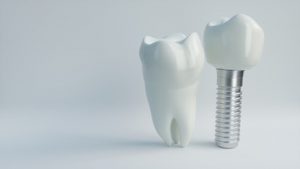If you’ve recently endured a tooth extraction, you’re probably wondering what to do about the new gap in your smile. Chances are, you’d like to replace that missing pearly white as soon as possible! One option that might pique your interest is receiving a dental implant; after all, they’re consider the premier option for replacing missing teeth. But how soon after your extraction should you look into replacing your tooth with an implant? Keep reading to learn more.
Why You Shouldn’t Wait to Replace Missing Teeth
One of the biggest problems associated with missing teeth, regardless of how they were lost, is that it often leads to additional missing teeth! This means that replacing an extracted tooth is always going to be in your best interest. If there’s a gap in your smile, your confidence isn’t all that’s negatively impacted—the teeth adjacent to the gap will gradually begin leading towards the open space, weakening and eventually falling out.
Once these teeth begin falling out, all sorts of complications can arise including bite pattern problems, trouble eating and talking, and an increased risk of oral infection. But by replacing lost teeth, you’re filling those empty sockets once more and ensuring that the neighboring teeth stay put. And there’s no better tooth replacement option than a dental implant, as it fully restores the entire structure of the lost tooth from roots-to-crown.
How Soon After a Tooth Extraction Can I Get a Dental Implant?
If you’ve opted to receive a dental implant to replace your extracted tooth, it then becomes a matter of when you can receive it. On average, patients will typically need to wait a minimum of 10 weeks after the extraction to receive their implant, to give their mouth the chance to heal. However, this timeframe can sometimes vary, and there are typically three categories of implant placement to consider:
- Immediate placement – If you have sufficient bone structure and good oral health following your tooth extraction, your dentist might be able to immediately place your implant following your extraction. This is often possible if the tooth has been lost due to trauma or injury. Once the implant has been placed, it will begin fusing with your jawbone over the next few months.
- Early placement – Also referred to as immediate-delayed placement, this usually occurs 2 – 3 months after your tooth extraction. The need for this minimal delay is often due to damaged gums or an infection that must heal before placement.
- Delayed placement – If your oral health is compromised, your implant won’t be able to properly fuse with your jawbone—meaning that your placement procedure needs to be put on hold. For example, if you don’t have adequate jawbone density to support implants, you might need a supplemental bone graft, which can add several months to your timeline. You might also have a gum infection that requires extensive treatment beforehand.
If you’ve recently undergone a tooth extraction, you shouldn’t’ hesitate to restore your lost tooth with a dental implant. Replacing the tooth in the correct manner and at an appropriate time will ensure your implant is set up for lasting success!
About the Author
Dr. Ronald A. Moreno has proudly served patients and families in Bellingham for several decades. Dr. Moreno received his dental doctorate from Georgetown University and is an active member of the American Dental Association and the Mount Baker District Dental Society. His practice is pleased to offer many available services including dental implants. If you have a missing tooth that you need to replace, don’t hesitate to contact Dr. Moreno through his practice’s website or by phone: (360) 676-0642.


